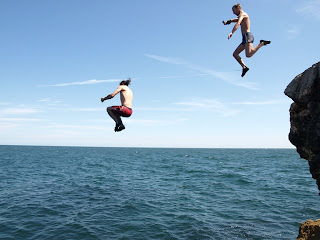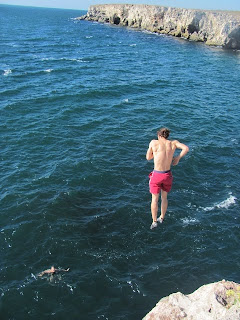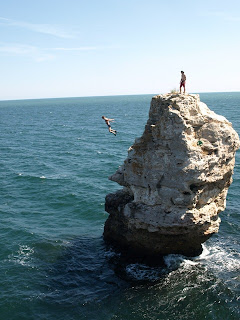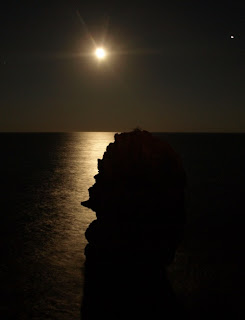Seaside cliff jumping and deep water solo climbing (DWS) can be fun activities but there are a few things you should consider before jumping into these sports. So let's dive in.
Yes it looks joyful and splashy but you have to remember that climbing and related sports are considered extreme sports. This doesn't mean you can't enjoy it but make sure you know what you're doing.
If you only want to jump into the sea then you must have these checked:
- Make sure you can swim. If you're a poor swimmer you'll struggle to get out, especially if the waves are big. If you can't swim, only enter in still waters wearing a swimming vest - under the close supervision of friends who can swim. Of course you won't be able to jump while wearing the vest but if you insist, do it from a height of two meters (six feet) above the sea or less. Being buoyant (with the vest on) you won't sink deep enough and you may even rip the vest (not to mention the impact shock your body will receive).
- Is the water deep enough for a high jump? You don't wanna hit the rocks on the seabed so check the jumping spots before you leap. Don't take chances as this may lead to fatal injuries (broken spine, broken legs, etc). A depth of at least four meters (12 feet) is required for 10 meters (30 feet) jumps. At 8'20" in the video above you can see an injury case which proved to be trivial (minor scratches) but being too cautious is never wrong!
- Wear climbing shoes - even if you don't want to climb high cliffs. Wearing shoes has two benefits: you won't splash your feet against the water and you won't cut your sole while climbing out. The limestone rocks are razor sharp below the water line - you won't regret having your feet protected.
- Can you maintain vertical balance while airborne? Well...when I jumped from that tower I leaned forward and hit my chest against the water so badly that it took me approximately 10 seconds to recover my breath and to be able to speak (I was basically speechless...). Chris Sharma says in one video (King Lines - scene with limestone arch route Es Pontas) that he heard of people "breaking ribs, collapsing their lungs" - oh yeah, that's definitely possible! Start with small jumps and go for the big air gradually! It's all about maintaining a good vertical balance in midair and tucking your limbs close to your body just before breaking the water surface (apparently I lost the mastery of this...).
- Is there an easy way out? If you can't climb too well then you should make sure there's a safe exit out of the sea, like a bay with still water and a stairway-like rock feature. Don't force your friends to save you. We had to do this once and it wasn't fun.
- Where's the chalk? 1.Climb without chalk - it works. 2.Carry a dozen of chalk bags (just like Sharma does when he shoots his videos). You will wet one on each time you fall. 3.Apply liquid chalk on your hands and shoulders - when your palm gets sweaty just rub it on your opposite shoulder. This is a neat solution that doesn't imply sacrificing your chalk bag.
- Beware of big waves and tight overhanging corners. If you wanna climb that overhang that starts just above the water surface wait for a day when the sea is calm. Don't push it or else...
- Loose rocks or thin horizontal holds (slates) may lead to unexpected falls. Choose your climbing route wisely.
Some of my friends explicitly asked me not to reveal online where this place is. Their reasons (and mine as well)?! Whenever a places grows too popular it also grows unpleasant due to traffic, urban sprawl like in real estate development, more trash, more noise, etc. I'll tell you this - it's a small village in Bulgaria. I'm sure the right people will be able to Google all the info.
If you get there please live like a nomad and don't check in in hotels or villas. If you do need comfort however, talk to the owners and tell them it's their responsibility to develop this place without destroying it. Educate them to educate their tourists.
Other things you should know if you're going DWS climbing in Bulgaria:
- As a nomad (sleeping in tent or in caves and eating from your backpack) you will need lots of drinking water. I'm still not sure how the villagers get their water - it may be from deep drilled wells. The limestone shore is flat and approximately 20 meters high above the sea so you won't find any fresh water springs.
- Bring your snorkeling gear or at least a pair of swimming goggles. You won't regret it. Where there are rocks there's sea-life: crabs, fish, plants, cormorants, dolphins, etc. Actually the place is awesome for scuba diving and underwater caving. There's an entire colony of cormorants in a cave that goes more than 30 meters deep under the limestone shoreline.
- Fishing is another popular activity - either with a rod or with a spear/harpoon while diving (I've seen divers doing this).
- Photography and film-making - bring your photo and video gadgets coz there's a lot to shoot. I improvised a wrist mount for the GoPro HD camera out of the head strap - I rolled the elastic straps a few times around my wrist and held the plastic square on which the camera was mounted. When I had to come out of the water (climb on cliffs), I slid the strap on my arm just after the elbow joint as to have the camera protected.
Es Pontas - Deep Water Solo Climbing Teaser - Chris Sharma
Es Pontas - Full Climb
Be safe!
Thanks for stopping by! Share this article with your friends.
























These are just cool images! Thanks for all the info. Kind of sad that some basics like knowing how to swim might be overlooked by thrillseekers.
ReplyDeleteThanks Kovas!
ReplyDeleteThe water and the sea are inviting. That's why our friend took the leap without being able to climb back. :-) Everything was fine in the end.
Great music "the sand feels as smooth as silk" Does anyone know the name of this sound track?
ReplyDeleteI can't remember the name of the song but I think I took it from Danosongs.com. A great resource for royalty free music to be used in video soundtracks.
ReplyDeleteThank you very very much Constantin! I found it. The song is called Silk and you are right this site is a great source of RF music.
ReplyDeleteGlad you like it, Bruce!
ReplyDeleteCheers!
Hi Constantin,
ReplyDeleteI am actually from Bulgaria but I have never been to Shabla. Since I am big fan of the high cliff dives but I have never trained any climbing my question is whether a person who is layman in climbing can still enjoy jumping. I mean keeping in mind that I am an overall athletic person will I be able to safely get out of the water after the jumps? Tnx
Sergey
Hey Sergey!
ReplyDeleteYup! You don't have to be a climber to cliff jump. There are easy "exits" out of the water, some of them involve basic climbing (like you would do on a steep valley in the mountains).
Those spots are okay for athletic persons.
So basically in all jumping areas there is at least one easy exit. The bay with the limestone arch is one of them - lots of non climbers come there; snorkeling fans and scuba divers as well.
Climbing skills, swimming abilities, coordination and power in your arms are essential to safely go out when there are big waves - especially if you want to get out of the water on the climbing lines.
We had an unpleasant experience this year (June 2011) where the waves almost tripled in size after we jumped... My friend was swept away from "safe zone" (3 meters above sea level) and I've been dragged down in the sea, my body twisted in all directions from the wave force.
We immediately swam away from the rock face and had a short agony swim (hardly, due to strong current) to an easy exit (a rock ledge just 30 cm higher than normal sea level).
So one has to be a good swimmer and keep calm when there are big waves.
We had similar experiences last years when we had to "save" a girl. She was a good swimmer but not a climber and after she got cuts in her legs from the sharp rock, her swimming ability also declined due to panic.
Anyway, each year I learn that fun as it may be, cliff jumping has it's perils.
I recommend jumping from small heights at first and gradually increase your exposure (if that's what you want). Also being with other people is essential as they can help you in case something goes wrong.
Usually I noticed that athletic persons perform well in any type of new physical activity (unlike non athletic persons). So you'll be fine! :-)
PS - we may come back there in August. Maybe we'll meet.
Cheers!